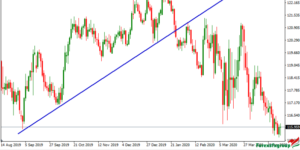Forex trading, also known as foreign exchange trading, is the process of buying and selling currencies with the aim of making a profit. It’s a dynamic market that operates 24 hours a day, five days a week, with trillions of dollars exchanged daily. Amidst various trading strategies, “price action trading” stands out for its simplicity, effectiveness, and applicability across different markets. In this comprehensive guide, we‘ll delve into the principles and techniques of Forex trading with price action.
Mastering Forex Trading with Price Action Strategies
Understanding Price Action Trading

Price action trading is a methodology that relies solely on the movement of prices on a chart to make trading decisions. It disregards the use of lagging indicators and instead focuses on interpreting the story that price movements tell. Traders who utilize price action techniques believe that all necessary information to make trading decisions is contained within the price movements themselves.
The Core Principles of Price Action Trading
- Support and Resistance: Support and resistance levels are crucial concepts in price action trading. Support represents a price level where buying interest is sufficiently strong to overcome selling pressure, preventing the price from falling further. Resistance, on the other hand, is a price level where selling interest is robust enough to halt upward price movement. Identifying these levels helps traders anticipate potential price reversals or breakouts.
- Candlestick Patterns: Candlestick patterns provide valuable insights into market sentiment and can indicate potential reversals or continuations in price trends. Common candlestick patterns include doji, hammer, engulfing patterns, and more. Traders often combine candlestick patterns with other price action concepts to refine their trading decisions.
- Trend Analysis: Identifying the prevailing trend is essential in price action trading. Trends can be classified as uptrends, downtrends, or sideways trends. Traders typically look for higher highs and higher lows in an uptrend and lower highs and lower lows in a downtrend. Trading in the direction of the trend increases the probability of successful trades.
- Price Action Signals: Price action signals are specific price movements or patterns that indicate potential trading opportunities. These signals can include pin bars, inside bars, and outside bars, among others. Traders use these signals in conjunction with other price action principles to confirm their trade setups.
Price Action Strategies for Forex Trading

- Breakout Trading: Breakout trading involves entering a trade when the price breaks above resistance or below support levels. Traders wait for a significant breakout with strong momentum to confirm the validity of the trade setup. Breakout trading can be highly profitable during periods of high volatility, but traders must exercise caution to avoid false breakouts.
- Trend Continuation: Trend continuation strategies involve entering trades in the direction of the prevailing trend. Traders look for pullbacks or retracements within an established trend to enter trades at favorable prices. This strategy allows traders to capitalize on the momentum of the trend while minimizing risk.
- Reversal Trading: Reversal trading aims to identify potential trend reversals before they occur. Traders look for signs of exhaustion in the prevailing trend, such as divergences between price and momentum indicators or overextended price movements. Reversal traders often use candlestick patterns and support/resistance levels to confirm their trade setups.
- Range Trading: Range trading involves identifying price ranges or consolidation phases where the price oscillates between support and resistance levels. Traders aim to buy at support and sell at resistance, profiting from the price movements within the range. Range trading requires patience and disciplined risk management to avoid getting caught in false breakouts.
Risk Management in Price Action Trading
Effective risk management is paramount in price action trading to preserve capital and ensure long-term profitability. Traders should adhere to strict risk-reward ratios, only risking a small percentage of their trading capital on each trade. Additionally, implementing stop-loss orders and position sizing strategies can help mitigate losses and protect against adverse market movements.
Advanced Price Action Techniques

- Confluence: Confluence occurs when multiple price action signals or indicators align to reinforce a trading decision. For example, a pin bar rejection at a key support level accompanied by bullish divergence on the RSI (Relative Strength Index) can provide strong confluence for a long trade. Traders should prioritize trades with higher confluence, as they typically have a higher probability of success.
- Contextual Analysis: Contextual analysis involves considering broader market factors, such as economic releases, geopolitical events, and market sentiment, to contextualize price action signals. For instance, a bullish pin bar pattern may carry more significance in an uptrending market with positive fundamental developments compared to a market plagued by uncertainty and volatility.
- Price Action Patterns: Beyond individual candlestick patterns, traders can analyze the formation and behavior of price action patterns to gain insights into market dynamics. Patterns such as head and shoulders, double tops/bottoms, and triangles can signal potential reversals or continuations in price trends. Understanding the psychology behind these patterns can enhance trade analysis and decision-making.
- Multiple Time Frame Analysis: Incorporating multiple time frame analysis allows traders to gain a comprehensive view of the market’s price action across different time frames. By aligning the signals from higher time frames (e.g., daily or weekly) with those from lower time frames (e.g., hourly or 15-minute), traders can identify high-probability trade setups while ensuring alignment with the broader market trend.
Conclusion
Forex trading with price action strategies offers a flexible and intuitive approach to navigating the dynamic currency markets. By focusing on the raw price movements and understanding the underlying market dynamics, traders can develop a deeper appreciation for market behavior and make more informed trading decisions. However, mastering price action trading requires dedication, patience, and a commitment to continuous learning. By integrating price action principles into their trading arsenal, Forex traders can enhance their probability of success and achieve their financial goals in the world’s largest financial market.

